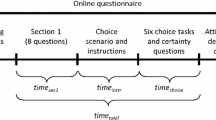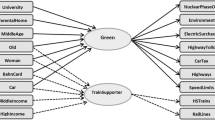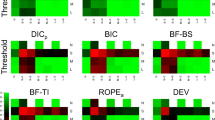Abstract
Response time latencies have been shown to influence consumer’s choice behaviour in choice-based-conjoint studies. The literature has shown that response time latencies affect the mean outputs of parameter estimates derived from models of discrete choice. In this paper, we add further insight into the influences response time latencies have on such models by modelling latent response information associated with the variance of random parameter distributions through parameterisation of variance heterogeneity (or heteroskedasticity). We demonstrate that response time latencies influence not only the means of random parameter distributions, but also the variances, and that failure to account for both may result in incorrect model inferences being drawn.
Similar content being viewed by others
References
Arentze, T., Borgers, A., Timmermans, H., & DelMistro, R. (2003). Transport stated choice responses: Effects of task complexity, presentation format and literacy. Transportation Research Part E, 39, 229–244.
Bettman, J.R., Luce, M.F., & Payne, J.W. (1998). Constructive consumer choice processes. Journal of Consumer Research, 25(Dec.), 187–217.
Bhat, C. (1998) Accommodating variations in responsiveness to level-of-service variables in travel mode choice modeling. Transportation Research Part A, 32(7), 495–507.
Bhat, C. (2000) Incorporating observed and unobserved heterogeneity in urban work mode choice modeling. Transportation Science, 34(2), 228–238.
Bhat, C., & Zhao, H. (2002). The spatial analysis of activity stop generation. Transportation Research Part B, 36(6), 557–575.
Bockenholt, U., Dietrich, A., Aschenbrenner, M., & Schmalhofer, F. (1991). The Effects of Attractiveness. Dominance, and Attribute Differences on Information Acquisition in Multiattribute Binary Choice. Organizational Behavior and Human Decision Processes, 49(2), 25B–81.
Brownstone, D., Bunch, D.S., & Train, K. (2000). Joint mixed logit models of stated and revealed preferences for alternative-fuel vehicles. Transportation Research B, 34(5), 315–338.
Chase, W.G., & Simon, H.A. (1973). Perception in chess. Cognitive Psychology, 4(Iss 1), 55–81.
Cooke, A.D., & Mellers, B.A. (1995). Attribute range and response range: Limits of compatibility in multiattribute judgment. Organizational Behavior and Human Decision Processes, 63(2), 187–194.
Dellaert, B.G.C., Brazell, J.D., & Louviere, J.J. (1999). The effect of attribute variation on consumer choice consistency. Marketing Letters, 10, 139–147.
De Palma, A., Myers, G., & Papageorgiou, Y. (1994). Rational choice under imperfect ability to choose. American Economic Review, 84, 419–440.
DeShazo, J. R., & Fermo, G. (2002). Designing choice sets for stated preference methods: The effects of complexity on choice consistency. Journal of Environmental Economics and Management, 44(1), 123–143.
Dhar, R., & Nowlis, S. M. (1999). The effect of time pressure on consumer deferral. Journal of Consumer Research, 25(March), 369–384.
Espinoza-Varas, B., & Watson, C. (1994). Effects of decision criterion on response latencies of binary decisions. Perception and Psychophysics, 55(2), 190–203,
Fazio, R.H. (1989). On the power and functionality of altitudes: The role of attitude accessibility. In R.P. Anthony, J.B. Steven, and G.G. Anthony (Eds.), Attitude Structure and Function, (pp. 153–179). Hillsdale, NJ: Lawrence Erlbaum Associates.
Gobet, F., & Simon, H.A. (1996). The roles of recognition processes and look-ahead search in time-constrained expert problem solving: Evidence from grandmaster level chess. Psychological science, 7(1), 52–55.
Greene, W.H., Hensher D.A., & Rose J.M. (2005). Using classical simulation-based estimators to estimate individual WTP values. In R. Scarpa and A. Alberini (Eds.), Applications of simulation methods in environmental and resource economics, (Ch. 2, pp. 17–34), Dordrecht, Netherlands: Springer Publisher.
Greene, W.H., Hensher, D.A., & Rose, J.M. (2006). Accounting for heterogeneity in the variance of unobserved effects in mixed logit models. Transportation Research Part B, 40(1), 75–92.
Haaijer, R., Wagner, K., & Wedel, M. (2000). Response latencies in the analysis of conjoint choice experiments. Journal of Marketing Research, XXXVII(Aug.), 376–382.
Hensher, D.A. (2004). Accounting for stated choice design dimensionality in willingness to pay for travel time aavings. Journal of Transport Economics and Policy, 38(2), 425–446.
Hensher, D.A. (in press, a) How do Respondents Process Stated Choice Experiments? Attribute consideration under varying information load Journal of Applied Econometrics.
Hensher, D.A. (in press, b) Revealing differences in behavioural response due to the dimensionality of stated choice designs: An initial assessment. Environmental and Resource Economics (Invited Paper DoD#).
Hensher, D.A. (in press, c) Attribute processing in choice experiments In B. Kanninen (Ed.), Valuing Environmental Amenities using Stated Choice Experiments: A Common Sense Guide to Theory and Practice, Berlin: Springer.
Hensher, D.A., & Greene, W.H. (2003). Mixed logit models: State of practice. Transportation, 30(2), 133–176.
Hensher, D.A., Rose, J.M., & Greene, W.H. (2005). Applied choice analysis: A primer. Cambridge: Cambridge University Press,
Howard, J., & Sheth, I. (1969). The theory of buyer behavior, New York: Wiley.
Jaeger, S.R., Hedderley, D., & MacFie, H.J.H. (2001). Methodological issues in conjoint analysis: A case study. European Journal of Marketing, 35(11/12), 1217–1237.
Louviere, J.J. (2001). What if consumer experiments impact variances as well as Means? Response variability as a behavioral phenomenon. Journal of Consumer Research, 28, 506–511.
McFadden, D., & Train, K. (2000). Mixed MNL models for discrete response. Journal of Applied Econometrics, 15, 447–470.
Ohler, T., Li, A., Louviere, J.J., & Swait, J., (2000). Attribute range effects in binary response tasks Marketing Letters, 11(3), 249–260.
Pollay, R.W. (1970) The structure of executive decisions and decision times. Administrative Science Quarterly, 15(4), 459–471.
Pullman, M.E., Dodson, K.J., & Moore, W.L. (1999). A comparison of conjoint methods when there are many attributes. Marketing Letters, 10(2), 1–14.
Rose, J.M., & Black, I.R. (2004). Response time influences on stated preference choice experiments, presented at 33rd European Marketing Academy Conference, Mucia, Spain.
Suri, R., & Monroe, K.B. (2004). The effects of time constraints on consumers’ judgments of prices and products. Journal of Consumer Research, 30(June), 92–104.
Swait, J., & Adamowicz, W. (2001). The influence of task complexity on consumer choice: A latent class model of decision strategy switching. Journal of Consumer Research, 28, 135–148.
Train, K. (2003). Discrete Choice Methods with Simulation. Cambridge: Cambridge University Press.
Verlegh, P.W., Schifferstein, H.N., & Wittink D.R. (2002). Range and number-of-levels effects in derived and stated measures of attribute importance. Marketing Letters, 13(1), 41–52.
Author information
Authors and Affiliations
Corresponding author
Rights and permissions
About this article
Cite this article
Rose, J.M., Black, I.R. Means matter, but variance matter too: Decomposing response latency influences on variance heterogeneity in stated preference experiments. Market Lett 17, 295–310 (2006). https://doi.org/10.1007/s11002-006-8632-3
Issue Date:
DOI: https://doi.org/10.1007/s11002-006-8632-3




